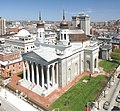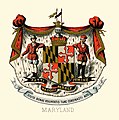|
Maryland Portal
|
Baltimore Task Force
|
Frederick Task Force
|
Montgomery Task Force
|
WikiProject Maryland
|
|
Main page
|
Discussion
|
Introduction Maryland (US: ⫽ˈmɛrɪlənd⫽ MERR-il-ənd) is a state in the Mid-Atlantic region of the United States. The state borders Virginia to its south, West Virginia to its west, Pennsylvania to its north, and Delaware, the Atlantic Ocean, and the national capital of Washington, D.C. to its east. With a total area of 12,407 square miles (32,130 km2), Maryland is the ninth-smallest state by land area, and its population of 6,177,224 ranks it the 18th-most populous state and the fifth-most densely populated. Maryland's capital is Annapolis, and the most populous city is Baltimore. Occasional nicknames include Old Line State, the Free State, and the Chesapeake Bay State. It is named after Henrietta Maria, the French-born queen of England, Scotland, and Ireland during the 17th century. Maryland's coastline was first explored by Europeans in the 16th century. Prior to that, it was inhabited by several Native American tribes, mostly the Algonquian peoples and, to a lesser degree, Iroquoians and Siouans. As one of the original Thirteen Colonies, Maryland was founded by George Calvert, 1st Baron Baltimore, a Catholic convert who sought to provide a religious haven for Catholics persecuted in England. In 1632, Charles I of England granted Lord Baltimore a colonial charter, naming the colony after his wife, Henrietta Maria. Unlike the Pilgrims and Puritans, Lord Baltimore envisioned a colony where people of different religious sects would coexist under the principle of toleration. In 1649, the Maryland General Assembly passed an Act Concerning Religion, which enshrined this principle by penalizing anyone who "reproached" a fellow Marylander based on religious affiliation. Religious strife was common in Maryland's early years, and Catholics remained a minority, albeit in greater numbers than in any other English colony. Maryland's early settlements and population centers clustered around rivers and other waterways that empty into the Chesapeake Bay. Its economy was heavily plantation-based and centered mostly on the cultivation of tobacco. Demand for cheap labor from Maryland colonists led to the importation of numerous indentured servants and enslaved Africans. In 1760, Maryland's current boundaries took form following the settlement of a long-running border dispute with Pennsylvania. Maryland was an active participant in the events leading up to the American Revolution, and in 1776, its delegates to the Second Continental Congress in Philadelphia signed the Declaration of Independence. Many of its citizens subsequently played key political and military roles in the American Revolutionary War. Although it was a slave state, Maryland remained in the Union during the American Civil War, and its strategic location made it a significant strategic location during the war. After the Civil War ended, Maryland took part in the Industrial Revolution, driven by its seaports, railroad networks, and mass immigration from Europe. Since the 1940s, the state's population has grown rapidly, to approximately six million residents, and it is among the most densely populated U.S. states. , Maryland had the highest median household income of any state, owing in large part to its proximity to Washington, D.C., and a highly diversified economy spanning manufacturing, retail services, public administration, real estate, higher education, information technology, defense contracting, health care, and biotechnology. Maryland is one of the most multicultural states in the country; it is one of the six states where non-Whites compose a majority of the population, with the fifth-highest percentage of African Americans, and high numbers of residents born in Africa, Asia, Central America, and the Caribbean. The state's central role in U.S. history is reflected by its hosting of some of the highest numbers of historic landmarks per capita. (Full article...) This is a Featured article, which represents some of the best content on English Wikipedia..
The 2008 Humanitarian Bowl was a postseason college football bowl game between the Maryland Terrapins and the Nevada Wolf Pack on December 30, 2008. It was the two teams' first meeting. The game featured two conference tie-ins: the University of Maryland represented the Atlantic Coast Conference (ACC) and the University of Nevada represented the Western Athletic Conference (WAC). The game was played at Bronco Stadium in Boise, Idaho and was the 12th edition of the Humanitarian Bowl. It was sponsored by the New Plymouth, Idaho-based company Roady's Truck Stops, which claims to be the largest chain of truck stops in the United States. The featured match-up was between what was called a "wildly inconsistent" Maryland team and the third-best rushing defense and fifth-best total offense of Nevada. The result was an offensive shoot-out. The final score of 42–35 in favor of Maryland exceeded total-points predictions by as much as 17 and tied the all-time Humanitarian Bowl record. (Full article...)General imagesIn the news
On this day...Births
This is a Good article, an article that meets a core set of high editorial standards.
The music of Baltimore, the largest city in Maryland, can be documented as far back as 1784, and the city has become a regional center for Western classical music and jazz. Early Baltimore was home to popular opera and musical theatre, and an important part of the music of Maryland, while the city also hosted several major music publishing firms until well into the 19th century, when Baltimore also saw the rise of native musical instrument manufacturing, specifically pianos and woodwind instruments. African American music existed in Baltimore during the colonial era, and the city was home to vibrant black musical life by the 1860s. Baltimore's African American heritage to the start of the 20th century included ragtime and gospel music. By the end of that century, Baltimore jazz had become a well-recognized scene among jazz fans, and produced a number of local performers to gain national reputations. The city was a major stop on the African American East Coast touring circuit, and it remains a popular regional draw for live performances. Baltimore has produced a wide range of modern rock, punk and metal bands and several indie labels catering to a variety of audiences. Music education throughout Maryland conforms to state education standards, implemented by the Baltimore City Public School System. Music is taught to all age groups, and the city is also home to several institutes of higher education in music. The Peabody Institute's Conservatory is the most renowned music education facility in the area, and has been one of the top nationally for decades. The city is also home to a number of other institutes of higher education that have music programs, the largest being nearby Towson University. The Peabody sponsors performances of many kinds, many of them classical or chamber music. Baltimore is home to the Baltimore Opera and the Baltimore Symphony Orchestra, among other similar performance groups. Major music venues in Baltimore include the nightclubs and other establishments that offer live entertainment clustered in Fells Point and Federal Hill. (Full article...)Selected article - The United States Naval Academy (USNA, Navy, or Annapolis) is a federal service academy in Annapolis, Maryland. It was established on 10 October 1845 during the tenure of George Bancroft as Secretary of the Navy. The Naval Academy is the second oldest of the five U.S. service academies and it educates midshipmen for service in the officer corps of the United States Navy and United States Marine Corps. It is part of the Naval University System. The 338-acre (137 ha) campus is located on the former grounds of Fort Severn at the confluence of the Severn River and Chesapeake Bay in Anne Arundel County, 33 miles (53 km) east of Washington, D.C., and 26 miles (42 km) southeast of Baltimore. The entire campus, known colloquially as the Yard, is a National Historic Landmark and home to many historic sites, buildings, and monuments. It replaced Philadelphia Naval Asylum in Philadelphia that had served as the first United States Naval Academy from 1838 to 1845 when the Naval Academy formed in Annapolis. Candidates for admission generally must apply directly to the academy and apply separately for a nomination, usually from a member of Congress. Students are officers-in-training with the rank of midshipman. Tuition for midshipmen is fully funded by the Navy in exchange for an active duty service obligation upon graduation. Approximately 1,200 "plebes" (an abbreviation of the Ancient Roman word plebeian) enter the academy each summer for the rigorous Plebe Summer. About 1,000 midshipmen graduate and commission. Graduates are commissioned as either ensigns in the Navy or second lieutenants in the Marine Corps, but a small number can also be cross-commissioned as officers in other U.S. services, and the services of allied nations. The United States Naval Academy has some of the highest-paid graduates in the country according to starting salary. The academic program grants a Bachelor of Science degree with a curriculum that grades midshipmen's performance upon a broad academic program, military leadership performance, and mandatory participation in competitive athletics. Midshipmen are required to adhere to the academy's Honor Concept. (Full article...)Did you know?

SubcategoriesSelect [+] to view subcategories
TopicsRelated portalsAssociated WikimediaThe following Wikimedia Foundation sister projects provide more on this subject:
Discover Wikipedia using portals |





















































